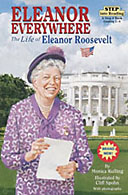Lesson Three: Eleanor Everywhere

Objectives:
- To reinforce reading biographies as a key to building a love for history.
- To show how one strong person can make a difference in the world.
- To learn what Eleanor Roosevelt did that made a difference in the US and in the larger world.
Methodology:
Classroom reading and discussion
Individual reading
Venn Diagram
Make a Movie
Activities:
1. Read Eleanor Everywhere: The Life of Eleanor Roosevelt by Monica Kulling (ISBN: 0-679-88996-5 Random House, 1999) $3.99
Read Eleanor Everywhere aloud over three consecutive days. (This book would also be wonderful for students to read individually; it would be a wonderful classroom set to have in the classroom.)
It would be helpful if you asked factual recall questions at the end of each session.
Examples:
After Chapter 1 ask, “What kind of a person did Eleanor ’s father want her to grow up to be?” (p. 9)
[He wanted her to grow up to be a brave woman.]
After Chapter 3 ask, “Why did Eleanor join the Junior League and the National Consumers’s League?” (p. 18-20)
[She wanted to help children and working women.]
After Chapter 5 ask, “When Franklin got sick Eleanor had to do things she didn’t think she could do. What were some of those things?” (pp.32-33)
[She learned to swim so she could swim with her children. She learned how to speak to an audience.]
After Chapter 6 ask, “What did Eleanor do during the Depression?” (p.37)
[She inspected prisons, hospitals, and homes for old people to see how people were being treated. She also went down in the coal mines to see how people were treated.]
After Chapter 7 ask, “What did Eleanor do after the Daughters of the American Revolution refused to let Marian Anderson sing in the hall?” (p.42)
[She spoke out against their decision, she quit the DAR and she arranged for Marian Anderson to sing at the Lincoln Memorial.]
After Chapter 8 ask, “What did Eleanor do at the United Nations?” (p. 45)
[She worked for peace and she helped write the Universal Declaration of Human Rights.]
Post Reading Activities
1. After you have finished the book do a Venn diagram with one circle showing the characteristics of a strong person and the other circle the characteristics of Eleanor Roosevelt.
The diagram should have room for many shared traits. Some traits for a strong person might include imagination (thinks about what to do; i.e. build a house) makes a plan (what do I need to build a house), works with others to get the house built. Some Eleanor Roosevelt characteristics include having dreams, honesty, fairness, bravery (overcoming fear), likes people and helps others. Shared characteristics include learning new things, speaking out, taking risks and getting things done.
2. Have students conceptualize a movie about Eleanor Roosevelt.
You have been hired to write a movie about Eleanor and it must be true. What are the 6 most important Eleanor actions you would put in the movie? (Examples: She overcame her fears. She like people and helped them whenever she could. She helped her husband become president of the United States. She was the First Lady. She wrote books, newspaper columns. She traveled all over America and the world helping people live safer, healthier, freer lives. She worked for peace at the United Nations. She helped write the Universal Declaration of Human Rights.) What is the most important thing you want the audience to know from watching your movie? (Example: She became a leader by helping people. She spent her whole life trying to make the world a better place.) Students may make storyboards or, technology permitting, even make a short film using stop-animation.
3. Ask your class what they can do to become leaders.
This educational program was prepared by The Eleanor Roosevelt Papers with funding from the GE Fund through Save America's Treasures.

